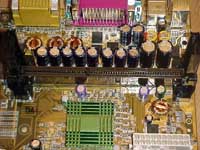To answer the next question without being asked first: no, the ASUS K7M cannot be used with the SuperG. The K7M has a row of capacitors placed flush against the Slot-A connector which would prevent the KryoCavity from being installed properly.
Like the previous Kryotech systems that we have taken a look at, the SuperG cools the nickel plate down to –36 C before powering up the system itself. If at any time the temperature rises too high, the base of the system immediately signals for power to be cut from the system. The base can control when the system turns on and shuts off is because the power switch is actually connected to a set of wires that run to the base of the system. Another set of wires is connected to the motherboard which control powering the system on and turning it off.
Our test system was outfitted with a Sparkle FSP300-60GT which is, naturally, on AMD’s Recommended Power Supply list. However, the combination of the FSP300-60GT and the 7IX resulted in a very serious problem with delivering enough current to the AGP slot.
This combination caused the system to lock as we ran 3D applications/games under Windows 98 when certain cards that draw quite a bit of current were used. The system seemed to work fine under NT, where not all of the AGP features are enabled as a result of NT’s limited support for AGP as anything other than an interface slot (AGP texturing/SBA are not enabled and thus the current requirements are lowered).
The problem resides either with the motherboard or the power supply; we’re currently investigating the problem even further to see the exact cause of the issue. This problem will affect those users purchasing the SuperG for gaming purposes, but it won’t trouble those using it for professional use under Windows NT since NT doesn’t support any AGP features other than the faster clock speed of the AGP bus.
Hitting 1GHz
In order to push the 750 to 1GHz (pronounced Gigahertz, not Gigahert), Kryotech had to make quite a few modifications to their system. The first was to increase the core voltage of the Athlon from 1.60v to 1.85v. This trick is quite common to overclockers: increasing the core voltage often helps achieve stability at overclocked speeds, and this was a necessary move for Kryotech in order to get the 750 to 1GHz. Don’t worry though - 1.85v is within the range of supported voltages for the Athlon, although it is a bit on the high side.
The SuperG features a larger compressor capable of dissipating 130% more heat than the original design, thus paving the way for a completely new line of Kryotech products that can scale to higher clock speeds and are flexible enough to accommodate other options. While the last part of that statement is a tad vague, we have been lead to believe that the SuperG will be much more upgrade friendly than the previous models, possibly capable of accepting future Athlon CPUs and motherboard configurations with a simple switch of the CPU or a few modifications to the existing design.
The new compressor is actually quieter than the older ones and, from our experience with it, it’s even quieter than Swiftech’s MC1000 Peltier cooler.












0 Comments
View All Comments